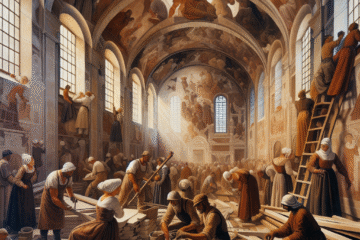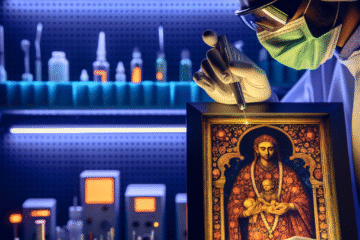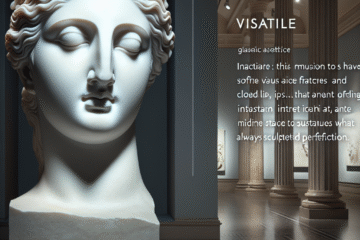I. Introduction
- Definition of the Baroque movement in art
- Historical context of the Baroque period (1600-1750)
- Key characteristics of Baroque art
The Baroque movement in art refers to the style of art that emerged in the late 16th century and continued through the 17th and early 18th centuries. It is characterized by its grandeur, drama, and emphasis on emotion and movement. The term “baroque” is derived from the Portuguese word “barroco,” which means “irregular pearl.” This is fitting as the art produced during this time period was often seen as excessive, ornate, and extravagant.
The Baroque period in art history coincides with the Baroque era in general, which saw significant social, political, and economic changes across Europe. The Catholic Church held significant power during this time and played a major role in the commissioning of art, leading to a proliferation of religious themes and imagery in Baroque art. The Baroque period also saw the rise of the nation-state and the emergence of absolute monarchies, which led to a focus on representing power and authority in art.
One of the key characteristics of Baroque art is the use of dramatic lighting and contrasts of light and shadow, known as chiaroscuro. This technique was used to create a sense of movement and emotion in the art, drawing the viewer’s attention to specific elements of the piece. Baroque art also often featured a sense of grandeur and theatricality, with bold and dynamic compositions, exaggerated poses, and a sense of movement. The use of symbolism and allegory was also prevalent in Baroque art, allowing for multiple layers of meaning in a single piece.
Another defining characteristic of Baroque art is the emphasis on realism, particularly in the representation of the human form. Artists of the Baroque period sought to capture the natural, expressive qualities of the human body, often portraying figures in dynamic poses with a high level of detail. This realism is also reflected in the use of everyday life and contemporary settings in Baroque paintings, rather than the mythological and historical scenes that were popular in earlier periods.
Overall, the Baroque movement in art was marked by a focus on grandeur, drama, and emotion, as well as an emphasis on realism and the representation of power and authority. The artistic style of the Baroque period was shaped by the historical context of the era, including the influence of the Catholic Church and the rise of the nation-state, and continues to be studied and admired for its ornate and opulent aesthetic.
II. The Evolution of Baroque Art
- Development of Baroque art in Italy
- Spread of Baroque art to other parts of Europe
- Influence of the Catholic Church on Baroque art
The evolution of Baroque art can be traced back to its origins in Italy, specifically in the city of Rome. The Baroque style in art emerged in the late 16th century as a reaction to the more static and rational style of the Renaissance. Artists began to experiment with new techniques such as the use of dramatic lighting and contrasts of light and shadow (chiaroscuro) to create a sense of movement and emotion in their works. This new style was quickly embraced by the Catholic Church, which was looking for a way to counter the Protestant Reformation and reassert its power and influence.
The Catholic Church played a major role in the development and spread of Baroque art. The Church commissioned many of the most important Baroque works, such as the sculptural decoration of St. Peter’s Basilica in Rome and the decoration of many other churches and cathedrals across Italy. The Church also sponsored the training of many Baroque artists and architects, who then went on to create works in other parts of Europe.
As the Baroque style spread across Italy, it began to influence art in other parts of Europe as well. Baroque art arrived in Spain in the late 16th century, and it quickly became popular among the Spanish nobility and the Church. In the 17th century, Baroque art spread to the courts of Northern Europe, particularly in the Netherlands, France, and England. Each country developed its own unique version of the Baroque style, reflecting their cultural, political, and economic circumstances.
The influence of the Catholic Church on Baroque art cannot be overstated. The Church’s patronage and commissioning of art, as well as its sponsorship of artists and architects, helped to establish the Baroque style as the dominant artistic style of the period. The Church also played a major role in shaping the themes and imagery of Baroque art, which often featured religious subjects and allegory. Many of the most famous Baroque works, such as the sculptures of Gianlorenzo Bernini and the paintings of Caravaggio, were created for the Church and reflect its influence on the art of the time.
In conclusion, the evolution of Baroque art can be traced back to its origins in Italy, where it emerged as a reaction to the more static and rational style of the Renaissance. The Baroque style quickly spread to other parts of Europe, where it was adapted to reflect the cultural, political, and economic circumstances of each country.
The Catholic Church played a major role in the development and spread of Baroque art through its patronage and commissioning of works, as well as its sponsorship of artists and architects. The Church’s influence can be seen in the religious themes and imagery that are prevalent in Baroque art, and in the use of grandeur and drama to convey emotion and movement. The spread of Baroque art across Europe and its adaptation to the different cultural and political contexts of each country helped to establish it as the dominant artistic style of the Baroque period. The influence of the Catholic Church, together with the cultural context, allowed the Baroque art to evolve and become a powerful means of religious, political and social expression, that resonated with the society of the time.
III. Themes and Motifs in Baroque Art
- Religious themes and imagery
- Use of drama and grandeur in Baroque art
- Representation of power and authority in Baroque art
The themes and motifs in Baroque art reflect the social, political, and religious context of the period. One of the most prominent themes in Baroque art is religious imagery and themes. The Catholic Church played a major role in the commissioning and sponsorship of Baroque art, and as a result, many Baroque works feature religious subjects such as scenes from the Bible, depictions of saints and other religious figures, and allegorical imagery.
One of the defining characteristics of Baroque art is its use of drama and grandeur. Artists of the Baroque period sought to create a sense of movement and emotion in their works, often through the use of bold and dynamic compositions, exaggerated poses, and a sense of theatricality. This emphasis on drama and grandeur can be seen in many famous Baroque works, such as Gianlorenzo Bernini’s sculptures, which often feature dynamic poses and a sense of movement.
Another important theme in Baroque art is the representation of power and authority. The rise of the nation-state and the emergence of absolute monarchies during the Baroque period led to a focus on representing power and authority in art. Many Baroque paintings and sculptures depict kings, queens, and other members of the nobility in grand and powerful poses. This emphasis on power and authority can also be seen in the use of symbolism and allegory in Baroque art, which often conveyed political and social messages.
The use of religious themes and imagery in Baroque art reflects the Catholic Church’s influence on the art of the period, while the use of drama and grandeur was a way to convey emotion and movement. The representation of power and authority in Baroque art reflects the political context of the period and the rise of the nation-state and absolute monarchies. Together, these themes and motifs in Baroque art create a powerful visual language that reflects the social, political, and religious context of the Baroque period.
In conclusion, the themes and motifs in Baroque art reflect the social, political, and religious context of the period. The prominence of religious themes and imagery in Baroque art reflects the Catholic Church’s influence on the art of the period, while the use of drama and grandeur was a way to convey emotion and movement. The representation of power and authority in Baroque art reflects the political context of the period and the rise of the nation-state and absolute monarchies. These themes and motifs in Baroque art create a powerful visual language that continues to resonate with audiences today.
IV. Famous Baroque Artists and Their Works
- Caravaggio and his use of chiaroscuro
- Bernini and his sculptures
- Rubens and his Baroque paintings
The Baroque period saw the emergence of many talented and influential artists, each with their own unique styles and techniques. Three of the most famous Baroque artists are Caravaggio, Bernini, and Rubens, each of whom had a significant impact on the development of Baroque art and continue to be admired for their works today.
Caravaggio was an Italian painter who is considered one of the most important figures of the Baroque period. He is best known for his use of chiaroscuro, which is the technique of using strong contrasts of light and shadow to create a sense of depth and movement in a painting. Caravaggio’s paintings are characterized by their dramatic lighting, realistic portrayals of the human form, and emotional intensity. Some of his most famous works include “The Calling of Saint Matthew,” “The Supper at Emmaus,” and “The Conversion of Saint Paul.”
Bernini was an Italian sculptor, architect and painter who is considered one of the most important figures of the Baroque period. He is best known for his sculptures, which often feature dynamic poses, a sense of movement, and a high level of realism. Bernini’s sculptures are characterized by their grandeur and ornateness, and he is considered one of the greatest sculptors of all time. Some of his most famous works include “David,” “Apollo and Daphne,” and “The Ecstasy of Saint Teresa.”
Rubens was a Flemish painter who was one of the most important figures of the Baroque period in Northern Europe. He is best known for his Baroque paintings, which are characterized by their dynamic compositions, use of color, and strong sense of movement. Rubens’s paintings often depict religious and mythological subjects and are known for their sensuality and eroticism. Some of his most famous works include “The Descent from the Cross,” “The Raising of the Cross,” and “The Three Graces.”
In conclusion, Caravaggio, Bernini, and Rubens are three of the most famous Baroque artists and their works continue to be admired today. Caravaggio is known for his use of chiaroscuro, Bernini for his sculptures and Rubens for his Baroque paintings. Each of these artists had a significant impact on the development of Baroque art and their works continue to inspire and influence artists today.
V. The Legacy of the Baroque Movement
- Influence of Baroque art on later movements such as Rococo and Neoclassicism
- Continued relevance of Baroque art in contemporary culture
The Baroque movement in art has had a lasting impact on the history of art, and its influence can be seen in the art of later periods, such as Rococo and Neoclassicism.
The Rococo style, which emerged in the 18th century, was heavily influenced by the Baroque style in its use of ornate decoration and emphasis on elegance and grace. However, the Rococo style is considered a lighter, more playful and decorative version of the Baroque, with less emphasis on grandeur and drama.
On the other hand, Neoclassicism, emerged as a reaction to the excesses of the Baroque and Rococo styles, and it sought to revive the simplicity and harmony of classical art. Neoclassicism borrowed elements from the Baroque, such as the use of symmetry and the emphasis on order and harmony, but rejected the grandeur and drama of the Baroque style in favor of a more reserved and rational approach.
The influence of the Baroque style can also be seen in contemporary art and culture. The use of chiaroscuro, dynamic compositions, and the emphasis on emotion and movement are still used by contemporary painters, photographers, and filmmakers. The Baroque style has also been used in popular culture, such as music videos and advertising, to create a sense of grandeur and drama.
In conclusion, the Baroque movement in art has had a lasting impact on the history of art, and its influence can be seen in the art of later periods such as Rococo and Neoclassicism. The Baroque style’s emphasis on grandeur, drama, and emotion continues to resonate with contemporary audiences, and its techniques and themes continue to be used in various forms of contemporary art and culture.
VI. Conclusion
- Summary of key points discussed in the article
- Significance of the Baroque movement in the history of art.
The Baroque movement in art, which emerged in the late 16th century and continued through the 17th and 18th centuries, is characterized by its grandeur, drama, and emphasis on emotion and movement. The Baroque period saw significant social, political, and economic changes across Europe, and the Catholic Church held significant power during this time and played a major role in the commissioning of art.
The key characteristics of Baroque art include the use of dramatic lighting and contrasts of light and shadow (chiaroscuro), the emphasis on grandeur and theatricality, and the use of symbolism and allegory. The Baroque period also saw an emphasis on realism, particularly in the representation of the human form.
Famous Baroque artists such as Caravaggio, Bernini, and Rubens had a significant impact on the development of Baroque art and continue to be admired for their works today. The Baroque style had a lasting impact on the history of art, and its influence can be seen in later movements such as Rococo and Neoclassicism and it continues to be relevant in contemporary culture.
In conclusion, the Baroque movement in art was marked by a focus on grandeur, drama, and emotion, as well as an emphasis on realism and the representation of power and authority. The artistic style of the Baroque period was shaped by the historical context of the era, including the influence of the Catholic Church and the rise of the nation-state, and continues to be studied and admired for its ornate and opulent aesthetic. The Baroque movement in art is a significant and powerful chapter in the history of art, and its influence continues to resonate in the art of today.


